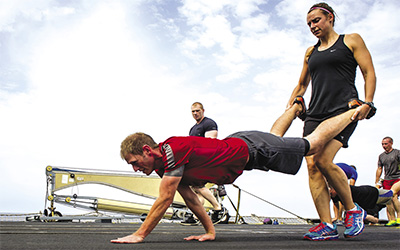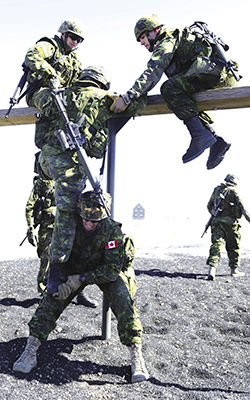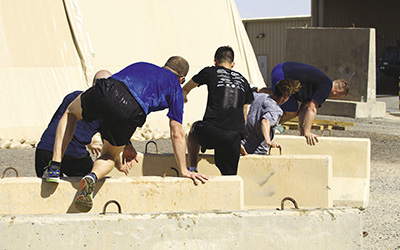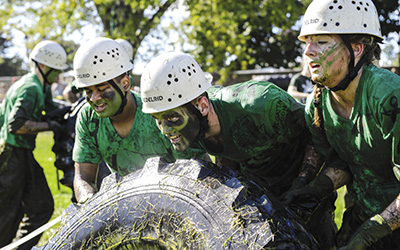VIEWS AND OPINIONS

DND photo ET2014-7144-08 by Corporal Michael Bastien
An Alternate View of Incentivized Fitness in the Canadian Armed Forces
by Major M.J. Draho
For more information on accessing this file, please visit our help page.
The latest Canadian Armed Forces fitness test – The FORCE Evaluation – has recently celebrated its second anniversary. Separately but relatedly, I attended a question and answer session with Commodore Watson, the Director General of the Canadian Forces Morale and Welfare Services, who provided insight into some initiatives being contemplated or unveiled by his organization in the coming year. One involved trials associated with ‘incentivizing’ the FORCE Evaluation. In short, those who undertake the evaluation would fall into one of two categories – those who achieved the standard and those who did not. That former group would be subsequently divided into five levels: the majority being those who simply passed, with the remainder (exact percentages/targets to be determined) split into Bronze, Silver, Gold, and the top two percent achieving the coveted Platinum level. It was not clear whether that breakdown would be based upon the total population, or by some other criteria, such as rank. As it stands, the concept sees those select few Platinum achievers issued a pin of some type to be worn on their uniform as a visible display of their physical prowess. Additionally, it was intimated additional non-discretionary points would be awarded for Platinum level fitness at national ranking boards, with the exact number of points yet to be decided.
I believe the FORCE Evaluation is a fit-for-purpose program. It is designed to be representative of a spectrum of physical demands one may expect to encounter during one’s career within the CAF. It provides a measurable physical fitness threshold for compliance with our universality of service requirements. For the vast majority, I believe it is viewed in exactly that light – the minimum standard to be eligible for retention in the CAF. The operational fitness required to perform one’s specific job within the CAF likely (hopefully) exceeds that standard by some margin. Further I believe most of us in uniform understand, accept, and embrace that reality – the FORCE Evaluation is not the end-state for fitness, but rather, a start point. So why be concerned about rewarding physical fitness and incentivizing the FORCE Evaluation?
For my part, I have two specific concerns that combined generate a third regarding the unintended organizational climate that incentivized fitness could create in the long term. My first concern relates to the relative importance of fitness in identifying our future leaders across the depth and breadth of the CAF. Awarding non-discretionary points for fitness at ranking boards serves to further erode the relative weight of performance, and, more importantly, potential scores and narratives, the latter of which should be of vital importance in selection for the next rank and appointment.
I do not dispute the need for leaders to be physically fit, or their need to lead from the front. However, it does not follow logically that the fittest individual equates to a better leader, and most worthy of promotion, particularly when the discriminator is an arbitrary tear-line separating the top two percent of FORCE Evaluation subjects from the rest. What is the qualitative difference between someone who scores in the second percentile of the FORCE Evaluation with someone in the third? I do not think it could be argued that the latter individual is not fit, or fit enough to lead. However, given the current scoring mechanisms at the boards, incentivized fitness will likely provide a numerical disadvantage of five or ten points – the number of points awarded for Platinum level fitness multiplied by the number of board members, which are usually five. So in real terms, prior to any consideration of performance or potential, someone scoring in the top three percentile of the FORCE Evaluation must overcome a five-to-ten point gap with someone who scored in the top two percentile. While I cannot speak definitively to all environments and branches, I offer that this is a reasonably significant barrier which seems completely arbitrary and within our ability to avoid.

DND photo LE2015-0024-18 by Master Corporal Mélanie Ferguson
Additionally if one were to ask not what is the difference between these individuals, but rather why the difference exists, the answer may cast incentivized fitness in a different light and highlight another potential source of concern. Perhaps the difference between the Gold and Platinum levels of fitness is the result of a slip at the start line, noted (or overlooked) protocol infractions, an inattentive invigilator, or simply deciding to undergo the evaluation while ‘under the weather’ in an effort to set an example within one’s organization. Today, the implications of all of the above scenarios are harmless (as long as you still pass the evaluation). However, with incentivized fitness, the consequences are profound. So, how much weight should be attributable to fitness before it undermines other assessment criteria and potentially serves as a de-motivator to the majority?
My second concern relates to motivation. Examining incentivized fitness from the perspective of motivation is revealing. At its most basic, motivation is either intrinsic or extrinsic in nature. Intrinsic motivation is the internal motivation to act, and, once resident, always present. As such, it is considered long-lasting and sustainable over time. Extrinsic motivation is an external motivator in the form of a reward or punishment, incentive, or rating that is not enduring. It is generally considered a short-term solution to motivation, and it is not sustainable because without the reward (or punishment), the motivation disappears. Further, keeping the reward (or punishment) at the same level will diminish the level of motivation over time, so it will wear off without additional or increased external motivational factors being added.
I believe we in the CAF should promote a culture whereby fitness is intrinsic – the need for fitness and its benefits are internalized – particularly in our leaders. The reward offered by incentivized fitness is most definitely extrinsic in nature and by extension fleeting. So, who do we want standing in front of that 500 person CAF unit – be it a ship, wing, or battalion? Someone who was externally rewarded for being incredibly fit? Or someone who intrinsically understands that value of fitness and can manage its requirement amongst a number of competing priorities? Fitness is important, and I would hope that our future leaders, whether junior or senior, officer or NCO, would have internalized the need for physical fitness rather than being externally rewarded for it via points at a merit board.
The foregoing two concerns, when combined, lead to my third and greatest concern with respect to incentivized fitness – its message and the subtle shift it imparts to our organizational culture over time. Not the intended and laudable message of promoting physical fitness, but rather, the unintended yet powerful message of rewarding fitness above so many other important professional development criteria. What appears at face value to be a worthy initiative may have the unintended consequence of creating an environment conducive to the promotion of attention-seekers, self-promoters, and those whose performance is driven by tangible rewards and incentives. Is it too far a stretch to suggest future leaders may be predisposed to transactional leadership, given its reliance upon reward and punishment rather than transformational leadership, which is far more reliant upon shared values? Such a shift in culture risks eroding our time-honoured tradition of selfless service and promoting the welfare and the interests of the organization ahead of oneself. Despite its intentions, I am not sure incentivized fitness will cultivate the correct culture, particularly among our leadership over time.

DND photo GD2015-0110-08
To be clear, I am an advocate of fitness, fitness testing, and gathering data to identify trends and target areas for improvement. Further, I believe that of all the fitness programs rolled out during the course of my 25+ years of service, the FORCE Evaluation is perhaps one of the better ones. But I believe incentivizing fitness carries with it detrimental effects that far outweigh its perceived benefits. Rather than promoting a culture of fitness, it risks, in the long term, promoting a culture that seeks personal recognition and undermines the weight of an assessment of one’s potential to work at the next rank.
By all means gather data, analyze it, and use it to best effect: namely identifying fitness trends that may emerge in relation to sex, age, environment, branch, region, unit, or rank. Use that data to refine or develop fitness programs (not tests) across these or any relevant cross-sections of the CAF to improve our overall fitness. But beyond that, I remain sceptical of the merits of an incentivized fitness program that includes awarding points at national ranking boards.
| 2013 | 2014 | 2015 | |
|---|---|---|---|
| Sandbag Lift | 1.08 | 1.04 | 1.03 |
| Intermittent Load Shuttle | 3.02 | 2.38 | 2.38 |
| 20 Metre Rushes | .36 | .36 | .35 |
| Sandbag Drag | P (no time recorded) | P .13 | P .14 |
And for the record, I am 47 years old and consider myself fit. I offer all three of my FORCE Evaluation scores, not to self-promote, but rather, to quieten those tempted to suggest these views are the result of my lack of fitness. I am proud of my scores despite not knowing how they measure up against the rest of the CAF population in general, or my contemporaries specifically with regard to national ranking boards. However, I am quite confident my scores have very little to do with my ability to work at the next rank, nor do I think they are a viable discriminator between my contemporaries and myself in deciding who is best suited and able to work at that next rank level.
I offer these views in the hope that they precipitate discussion and debate in order that Armed Forces Council may render a fully considered and informed decision as it deliberates the implementation of this initiative in the near future.
Mike Draho joined the Canadian Armed Forces in 1989, serving in the 3rd and 1st Regiments, Royal Canadian Horse Artillery; Headquarters 1st Canadian Mechanized Brigade Group; the Royal Regiment of Canadian Artillery School; and the Headquarters Director Royal Artillery and the Royal School of Artillery in the United Kingdom. Most recently, he serves in the Regimental Headquarters of the Royal Regiment of Canadian Artillery, where he is the Regimental Major.

CFB Kingston Base Photo







